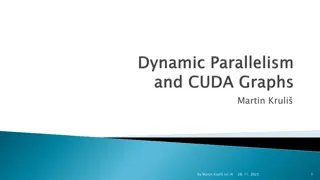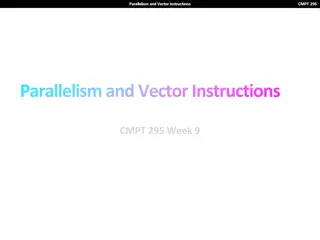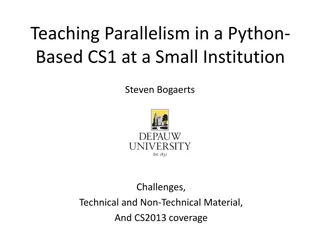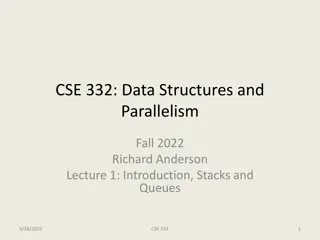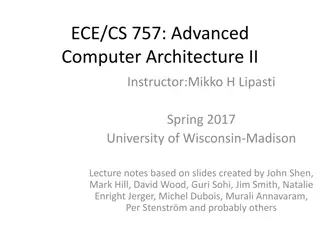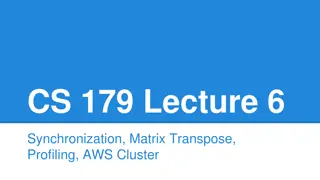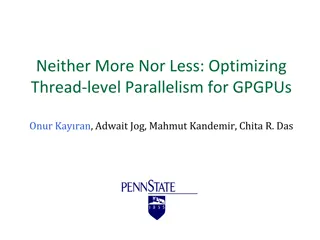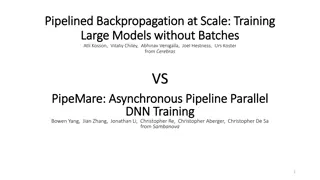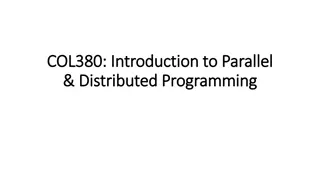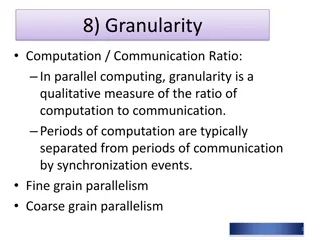
High-Performance Data Parallelism in Algorithms
Explore the concepts of data parallelism in algorithms, focusing on operations like map, filter, fold, reduce, scan, and more. Discover how to efficiently implement these operations for parallel machines, with examples in C++, Scala, Python, and functional languages like Haskell. Dive into key data-parallel operations like gather and scatter, understanding their significance in processing sequences of data efficiently.
Uploaded on | 2 Views
Download Presentation

Please find below an Image/Link to download the presentation.
The content on the website is provided AS IS for your information and personal use only. It may not be sold, licensed, or shared on other websites without obtaining consent from the author. If you encounter any issues during the download, it is possible that the publisher has removed the file from their server.
You are allowed to download the files provided on this website for personal or commercial use, subject to the condition that they are used lawfully. All files are the property of their respective owners.
The content on the website is provided AS IS for your information and personal use only. It may not be sold, licensed, or shared on other websites without obtaining consent from the author.
E N D
Presentation Transcript
Data Parallelism (2) Lecture 13 Hartmut Kaiser https://teaching.hkaiser.org/spring2025/csc4700/
3/13/2025, Lecture 13 Today s Theme (cont.) You are now accustomed to thinking about parallel programming in terms of what workers do and assigning work to workers Today I would like you to think about describing algorithms in terms of operations on sequences of data map filter fold / reduce scan / segmented scan CSC4700, Spring 2025, Data Parallelism (2) sort group_by join partition / flatten Main idea: high-performance parallel implementations of these operations exist So programs written in terms of these primitives can often run efficiently on a parallel machine (if you can avoid being bandwidth bound) 2
3/13/2025, Lecture 13 Key Data Type: Sequences Collection of elements In C++: vector<T> (actually any C++ container) Similar constructs exist in other programming languages: Scala lists: List[T] Python: Pandas Dataframes, Numpy arrays In a functional language (like Haskell): seq T Etc. CSC4700, Spring 2025, Data Parallelism (2) Important: data-parallel programs only access elements of a sequence through specific operations, not direct element access C++: Iterators 3
3/13/2025, Lecture 13 Other Key Data-parallel Operations gather(index, input, output) output[i] = input[index[i]] scatter(index, input, output) output[index[i]] = input[i] CSC4700, Spring 2025, Data Parallelism (2) 4
3/13/2025, Lecture 13 Key Data-Parallel Operations output_seq = gather(index_seq, data_seq) Gather data from data_seq according to indices in index_seq CSC4700, Spring 2025, Data Parallelism (2) 5
3/13/2025, Lecture 13 Gather Operation void gather() { std::vector<double> elements = {1., 2., 3., 4., 5., 6., 7., 8.}; std::vector<int> indices = {1, 0, 3, 5, 4, 6}; CSC4700, Spring 2025, Data Parallelism (2) std::vector<double> gathered; std::ranges::transform( indices, std::back_inserter(gathered), [&](int idx) { return elements[idx]; }); // gathered: {2., 1., 4., 6., 5., 7.} return 0; } 6
3/13/2025, Lecture 13 Key Data-Parallel Operations output_seq = scatter(index_seq, data_seq) Scatter data from data_seq according to indices in index_seq CSC4700, Spring 2025, Data Parallelism (2) 7
3/13/2025, Lecture 13 Aside: Zip Iterator The zip_iterator allows to iterate over more than one sequence at the same time It is initialized from a list of iterators, one for each of the sequences to combine When incremented, it increments all iterators it refers to When decremented, it decrements all iterators it refers to When compared with another zip_iterator, it compares all iterators it refers to pair-wise with the iterators of the other zip_iterator When dereferenced, it dereferences all iterators it refers to an returns a tuple of those results. CSC4700, Spring 2025, Data Parallelism (2) Iteration will stop once the first iterator reaches the end of its sequence 8
3/13/2025, Lecture 13 Aside: Zip Iterator A C++ zip iterator allows you to iterate over multiple ranges simultaneously: template <typename R1, typename R2, typename... Rs> auto zip(R1&& r1, R2&& r2, Rs&&... rs) { return iterator_range( zip_iterator(r1.begin(), r2.begin(), rs.begin()...), zip_iterator(r1.end(), r2.end(), rs.end()...)); } CSC4700, Spring 2025, Data Parallelism (2) int main() { std::vector<char> vec1{'r', 'n', 'e'}; std::vector<char> vec2{'a', 'g', 's'}; // Example usage of zip_iterator for (auto [ch1, ch2] : zip(vec1, vec2)) std::println("({}, {})", ch1, ch2); } 9
3/13/2025, Lecture 13 Aside: Zip Iterator (Simplified) template <typename It1, typename It2> struct zip_iterator { zip_iterator(It1 iter1, It2 iter2) : it1(iter1), it2(iter2) {} friend bool operator==(zip_iterator const& lhs, zip_iterator const& rhs) { return lhs.it1 == rhs.it1 || lhs.it2 == rhs.it2; } CSC4700, Spring 2025, Data Parallelism (2) auto operator*() { return std::make_tuple(*it1, *it2); } // dereference zip_iterator& operator++() { ++it1; ++it2; return *this; } // pre-increment zip_iterator operator++(int) { zip_iterator tmp = *this; ++it1; ++it2; return tmp; } // post-increment It1 it1; It2 it2; }; 10
3/13/2025, Lecture 13 Scatter Operation void scatter() { std::vector<double> elements = {1., 2., 3., 4., 5., 6., 7., 8.}; std::vector<int> indices = {1, 0, 7, 2}; CSC4700, Spring 2025, Data Parallelism (2) std::vector<double> scattered(elements.size(), 0.0); std::ranges::for_each( zip(indices, elements), [&](std::tuple<int, double> val) { scattered[std::get<0>(val)] = std::get<1>(val); }); // scattered: {2., 1., 4., 0., 0., 0., 0., 3.} return 0; } 11
3/13/2025, Lecture 13 Scatter/Gather Machine Instructions gather(R1, R0, mem_base); Gather from buffer mem_base into R1 according to indices specified by R0. CSC4700, Spring 2025, Data Parallelism (2) Gather/scatter SIMD instruction exist in AVX512 Hardware supported gather/scatter exists on GPUs. 12
3/13/2025, Lecture 13 More Sequence Operations: Sort Sort Sort elements in sequence based on given ordering criteria In C++: template <typename RandomIt, typename Compare> void sort (RandomIt first, RandomIt last, Compare comp); // defaults to std::less<> CSC4700, Spring 2025, Data Parallelism (2) template <typename RandomIt, typename Compare> void stable_sort (RandomIt first, RandomIt last, Compare comp); C++ also has parallel (stable-)sort: template <typename ExPolicy, typename RandomIt> void sort (ExPolicy policy, RandomIt first, RandomIt last); 13
3/13/2025, Lecture 13 Turning a Scatter into Sort/Gather Special case: assume elements of index are unique and all elements are referenced in index (scatter is a permutation) For each index element: output[index[i]] = input[i] CSC4700, Spring 2025, Data Parallelism (2) scatter(index, input, output) { output = sort input sequence by values in index sequence } 14
3/13/2025, Lecture 13 Turning a Scatter into Sort/Gather template <typename Range1, typename Range2, typename Iter> void scatter_sort(Range2 const& index, Range2 const& input, Iter output) { std::ranges::copy(input, output); std::ranges::sort( zip(index, output), [](auto const& l, auto const& r) { return get<0>(l) < get<0>(r); }); } CSC4700, Spring 2025, Data Parallelism (2) May be faster than na ve implementation because of spatial locality 15
3/13/2025, Lecture 13 More Sequence Operations: Filter Filter Produce a sequence of elements that match predicate In C++: CSC4700, Spring 2025, Data Parallelism (2) template <typename ForwardIt, typename UnaryPred> ForwardIt copy_if (ForwardIt first, ForwardIt last, UnaryPred p); remove_copy_if does the opposite, otherwise equivalent filter f 16
3/13/2025, Lecture 13 Filter Given an array input, produce an array output containing only elements such that f(element) is true Example: Input: [17, 4, 6, 8, 11, 5, 13, 19, 0, 24] f: element > 10 Output: [17, 11, 13, 19, 24] CSC4700, Spring 2025, Data Parallelism (2) Standard algorithm copy_if: template <typename ForwardIt, typename OutIt, typename UnaryPred> ForwardIt copy_if(ForwardIt first, ForwardIt last, OutIt dest, UnaryPred p) { for (ForwardIt i = first; i != last; ++i) { if (p(*i)) // retain elements that do match predicate *dest++ = *i; } return dest; } 17
3/13/2025, Lecture 13 Parallel Filter Parallelizable? Determining whether an element belongs in the output is easy But determining where an element belongs in the output is hard; seems to depend on previous results . CSC4700, Spring 2025, Data Parallelism (2) Solution: Step 1: parallel map to compute a bit-vector for true elements: Input: [17, 4, 6, 8, 11, 5, 13, 19, 0, 24] Bits: [ 1, 0, 0, 0, 1, 0, 1, 1, 0, 1] Step 2: parallel scan on the bit-vector (gives desired position in output): Bitsum: [ 1, 1, 1, 1, 2, 2, 3, 4, 4, 5] Step 3: parallel map to produce the output: Output: [17, 11, 13, 19, 24] 18
3/13/2025, Lecture 13 Parallel Filter void data_parallel_copy_if() { std::vector<double> elements = {1., 2., 3., 4., 5., 6., 7., 8.}; // map to compute a bit-vector for elements not matching predicate std::vector<char> flags(elements.size()); std::transform( first, last, flags.begin(), [](double val) { return val > 3.; }); CSC4700, Spring 2025, Data Parallelism (2) // scan on the bit-vector (gives desired position in output) std::vector<char> bitsum(elements.size()); std::inclusive_scan(flags.begin(), flags.end(), bitsum.begin()); // map to produce the output (gather) std::vector<double> output(bitsum.back()); std::ranges::for_each(zip(bitsum, elements), [&](auto curr) { output[std::get<0>(curr) - 1] = std::get<1>(curr); }); } 19
3/13/2025, Lecture 13 Parallel Filter First two steps can be combined into one pass Just using a different base case for the scan No effect on asymptotic complexity Can also combine third step into the down pass of the scan Again no effect on asymptotic complexity CSC4700, Spring 2025, Data Parallelism (2) Analysis: ?(?) work 2 or 3 passes, but 3 is a constant 20
3/13/2025, Lecture 13 Implementing scatterOp with atomic sort/map/segmented-scan Now, assume elements in index are not unique, so synchronization is required for atomicity! for all elements in sequence output[index[i]] = atomic_op(output[index[i]], input[i]) Example: atomicAdd(output[index[i]], input[i]) CSC4700, Spring 2025, Data Parallelism (2) Example: ????? = [1,1,0,2,0,0] Step 1: Sort input sequence according to values in index sequence Sorted index: [0,0,0,1,1,2] Input sorted by index: [?????[2],?????[4],?????[5],?????[0],?????[1],?????[3]] Step 2: Compute starts of each range of values with the same index number starts: [1, 0, 0, 1, 0, 1] Step 3: Segmented scan (using op ) on each range [??(??(?????[2],?????[4]),?????[5]),??(?????[0],?????[1]),?????[3])] 21
3/13/2025, Lecture 13 More Sequence Operations: Exercise Group by key Creates a sequence of sequences containing elements with the same key CSC4700, Spring 2025, Data Parallelism (2) group by key Reduce by key Creates pairs of values consisting of key and reduced result for corresponding values Sort by key As group by key, but the sequences are sorted Etc. 22
3/13/2025, Lecture 13 Scan/Segmented Scan Summary Scan Parallel implementation of (intuitively sequential application) Theory: parallelism in problem is linear in number of elements Practice: exploit locality, use only as much parallelism as necessary to fill the machine s execution resources Great example of applying different strategies at different levels of the machine CSC4700, Spring 2025, Data Parallelism (2) Segmented scan Express computation and operate on irregular data structures (e.g., list of lists) in a regular, data parallel way 23
3/13/2025, Lecture 13 CSC4700, Spring 2025, Data Parallelism (2) Examples Grid of Particles 24
3/13/2025, Lecture 13 Example: Create Grid of Particles Data Structure Problem: place 1M point particles in a 16-cell uniform grid based on 2D position Parallel data structure manipulation problem: build a 2D array of lists CSC4700, Spring 2025, Data Parallelism (2) 25
3/13/2025, Lecture 13 Common use of this Structure: N-Body Problems A common operation is to compute interactions with neighboring particles Example: given a particle, find all particles within radius R Organize particles by placing them in grid with cells of size R Only need to inspect particles in surrounding grid cells CSC4700, Spring 2025, Data Parallelism (2) N-Body problems require to compute pairwise forces between each pair of points Creating a mesh of points allows to reduce amount of required coputations 26
3/13/2025, Lecture 13 Create Grid of Particles Data Structure // one particle struct point { double x; double y; }; // the whole mesh (list of cells) struct mesh { size_t size_x = 0; size_t size_y = 0; std::vector<cell> cells; }; CSC4700, Spring 2025, Data Parallelism (2) // calculate the index of the cell for pt size_t find_cell_index( point const& pt, mesh const& m) { size_t pos_x = size_t(pt.x * m.size_x); size_t pos_y = size_t(pt.y * m.size_y); return pos_y * size_x + pos_x; } // a cell containing particles struct cell { point upper_left; point lower_right; std::vector<point> points; }; 27
3/13/2025, Lecture 13 Sequential Implementation double fill_mesh_sequentially( std::vector<point> const& points, size_t num_cells_x, size_t num_cells_y) { mesh m(num_cells_x, num_cells_y); timer t; t.start(); CSC4700, Spring 2025, Data Parallelism (2) for (point const& p : points) { size_t idx = find_cell_index(p, m); m.cells[idx].points.push_back(p); } t.stop(); return t.elapsed(); } 28
3/13/2025, Lecture 13 Solution 1: Parallelize over Particles One answer: assign one particle to each thread. Each thread computes cell containing particle, then atomically updates per cell list. Massive contention: thousands of threads contending for access to update single shared data structure CSC4700, Spring 2025, Data Parallelism (2) list cell_list[16]; // 2D array of lists lock cell_list_lock; for each particle p // in parallel c = compute cell containing p lock(cell_list_lock) append p to cell_list[c] unlock(cell_list_lock) 29
3/13/2025, Lecture 13 Solution 1: Parallelize over Particles double fill_mesh_parallel_v1( std::vector<point> const& points, size_t num_cells_x, size_t num_cells_y) { mesh m(num_cells_x, num_cells_x); timer t; t.start(); CSC4700, Spring 2025, Data Parallelism (2) hpx::mutex mtx; hpx::ranges::for_each(hpx::execution::par, points, [&](point const& p) { size_t idx = find_cell_index(p, m); std::lock_guard l(mtx); m.cells[idx].points.push_back(p); }); t.stop(); return t.elapsed(); } 30
3/13/2025, Lecture 13 Solution 2: Use finer-granularity Locks Alleviate contention for single global lock by using per-cell locks Assuming uniform distribution of particles in 2D space... ~16x less contention than previous solution CSC4700, Spring 2025, Data Parallelism (2) list cell_list[16]; // 2D array of lists lock cell_list_lock[16]; for each particle p // in parallel c = compute cell containing p lock(cell_list_lock[c]) append p to cell_list[c] unlock(cell_list_lock[c]) 31
3/13/2025, Lecture 13 Solution 2: Use finer-granularity Locks Alleviate contention for single global lock by using per-cell locks // a cell containing particles, now with a mutex struct cell { std::mutex mtx; point upper_left; point lower_right; std::vector<point> points; }; CSC4700, Spring 2025, Data Parallelism (2) 32
3/13/2025, Lecture 13 Solution 2: Use finer-granularity Locks double fill_mesh_parallel_v2( std::vector<point> const& points, size_t num_cells_x, size_t num_cells_y) { mesh m(num_cells_x, num_cells_y); timer t; t.start(); CSC4700, Spring 2025, Data Parallelism (2) std::ranges::for_each(std::execution::par, points, [&](point const& p) { size_t idx = find_cell_index(p, m); cell& c = m.cells[idx]; std::lock_guard l(c.mtx); c.points.push_back(p); }); t.stop(); return t.elapsed(); } 33
3/13/2025, Lecture 13 Solution 3: Parallelize over Cells Decompose work by cells: for each cell, independently compute what particles are within it (eliminates contention because no synchronization is required) Work inefficient: performs 16 times more particle-in-cell computations than sequential algorithm Possibly insufficient parallelism: only 16 parallel tasks, but need thousands of independent tasks to efficiently utilize GPU) CSC4700, Spring 2025, Data Parallelism (2) list cell_lists[16]; // 2D array of lists for each cell c // in parallel for each particle p // sequentially if (p is within c) append p to cell_lists[c] 34
3/13/2025, Lecture 13 Solution 3: Parallelize over Cells double fill_mesh_parallel_v3( std::vector<point> const& points, size_t num_cells_x, size_t num_cells_y) { mesh m(num_cells_x, num_cells_y); timer t; t.start(); CSC4700, Spring 2025, Data Parallelism (2) std::ranges::for_each(std::execution::par, m.cells, [&](cell& c) { std::ranges::for_each(points, [&](point const& p) { size_t idx = find_cell_index(p, m); if (c.idx == idx) c.points.push_back(p); }); }); 35 t.stop(); return t.elapsed(); }
3/13/2025, Lecture 13 Solution 3.1: Parallelize over Cells double fill_mesh_parallel_v3( std::vector<point> const& points, size_t num_cells_x, size_t num_cells_y) { mesh m(num_cells_x, num_cells_y); timer t; t.start(); CSC4700, Spring 2025, Data Parallelism (2) std::ranges::for_each(std::execution::par, m.cells, [&](cell& c) { std::ranges::copy_if( points, std::back_inserter(c.points), [idx = c.idx, &m](point const& p) { return idx == find_cell_index(p, m); }); }); t.stop(); return t.elapsed(); } 36
3/13/2025, Lecture 13 Solution 4: Compute partial Results & Merge Yet another answer: generate N partial grids in parallel, then combine results Example: create N threads per thread block (one thread block per core) Every thread in thread block updates same grid CSC4700, Spring 2025, Data Parallelism (2) Enables faster synchronization: contention reduced by factor of N and cost of synchronization is lower because it is performed on block-local variables Requires extra work: merging the N grids at the end of the computation Requires extra memory footprint: stores N grids of lists, rather than just one 37
3/13/2025, Lecture 13 Solution 4: Compute partial Results & Merge double fill_mesh_parallel_v4( std::vector<point> const& points, size_t num_cells_x, size_t num_cells_x) { mesh m(num_cells_x, num_cells_y); timer t; t.start(); CSC4700, Spring 2025, Data Parallelism (2) hpx::experimental::for_loop(hpx::execution::par, size_t(0), points.size(), hpx::experimental::reduction(m, combine_meshes), [&](size_t i, mesh& local_m) { point const& p = points[i]; size_t idx = find_cell_index(p, local_m); local_m.cells[idx].points.push_back(p); }); t.stop(); return t.elapsed(); } 38
3/13/2025, Lecture 13 Solution 4: Compute partial Results & Merge // Merge partial Results mesh& combine_meshes(mesh& acc, mesh const& curr) { for (size_t i = 0; i != acc.cells.size(); ++i) { auto& dest_points = acc.cells[i].points; auto const& src_points = curr.cells[i].points; dest_points.insert( dest_points.end(), src_points.begin(), src_points.end()); } return acc; } CSC4700, Spring 2025, Data Parallelism (2) 39
3/13/2025, Lecture 13 Solution 4: Compute partial Results & Merge // Merge partial Results mesh& combine_meshes_v2(mesh& acc, mesh const& curr) { std::ranges::for_each(zip(acc.cells, curr.cells), [](auto& curr) { std::ranges::copy(std::get<1>(curr).points, std::back_inserter(std::get<0>(curr).points)); }); return acc; } CSC4700, Spring 2025, Data Parallelism (2) 40
3/13/2025, Lecture 13 Solution 5: Data-parallel Approach Step 1: map Compute cell containing each particle (parallel over input particles) CSC4700, Spring 2025, Data Parallelism (2) Step 2: sort results by cell (notice that the particle index array is permuted based on sort) Step 3: find start/end of each cell (over particle_index elements) This solution maintains a large amount of parallelism and removes the need for fine-grained synchronization At the cost of a sort and extra passes over the data (extra BW)! 41
3/13/2025, Lecture 13 Solution 5: Data-parallel Approach // Compute cell containing each particle std::ranges::transform(std::execution::par, points, indices.begin(), [&](point const& p) { return find_cell_index(p, m); }); // Sort results by cell index std::ranges::sort(std::execution::par, zip(points, indices), [](auto const& l, auto const& r) { // args: std::tuple<point&, size_t&> return hpx::get<1>(l) < hpx::get<1>(r); }); CSC4700, Spring 2025, Data Parallelism (2) // find start/end of each cell, associate points with cells std::ranges::for_each(std::execution::par, m.cells, [&](cell& c) { auto [b, e] = std::ranges::equal_range(indices, c.idx); c.points.insert(c.points.end(), points.begin() + (b - indices.begin()), points.begin() + (e - indices.begin())); }); 42
3/13/2025, Lecture 13 Create Grid of Particles Data Structure: Results Mesh: 32x32 Mesh: 4x4 Mesh: 8x8 Mesh: 16x16 seq: 2331 [ms] par v1: 63897 [ms] par v2: 1215 [ms] par v3: 17834 [ms] par v4: 14490 [ms] par v5: 984 [ms] seq: 764 [ms] par v1: 59593 [ms] par v2: 6491 [ms] par v3: 707 [ms] par v4: 936 [ms] par v5: 918 [ms] seq: 1686 [ms] par v1: 57192 [ms] par v2: 2785 [ms] par v3: 1229 [ms] par v4: 1159 [ms] par v5: 876 [ms] seq: 1800 [ms] par v1: 59531 [ms] par v2: 1561 [ms] par v3: 5366 [ms] par v4: 3339 [ms] par v5: 897 [ms] CSC4700, Spring 2025, Data Parallelism (2) 43
3/13/2025, Lecture 13 CSC4700, Spring 2025, Data Parallelism (2) Examples Generate a Histogram 44
3/13/2025, Lecture 13 Another Example: Parallel Histogram Consider computing a histogram for a sequence of values // maps array values to histogram bin id's for float input[N]; int find_bin_index(float value); // bins are initialized to 0 std::vector<int> histogram_bins(NUM_BINS, 0); CSC4700, Spring 2025, Data Parallelism (2) for (int i = 0; i < N; ++i) ++histogram_bins[find_bin_index(input[i])]; Challenge: Create a parallel implementation of histogram given only map and sort on sequences 45
3/13/2025, Lecture 13 Data-parallel Histogram Construction (Version 1) // map find_bin_index onto input sequence to get bin ids of all elements hpx::ranges::transform(hpx::execution::par, input, bin_ids.begin(), [](float val) { return find_bin_index(val); }); // find starting point of each bin in sorted list hpx::ranges::sort(hpx::execution::par, bin_ids); CSC4700, Spring 2025, Data Parallelism (2) std::vector<int> bin_starts(NUM_BINS, -1); bin_starts[bin_ids[0]] = 0; // first bin starts with first element hpx::experimental::for_loop( hpx::execution::par, 1, bin_ids.size(), [&](size_t idx) { // store first index of input for every bin if (bin_ids[idx] != bin_ids[idx - 1]) bin_starts[bin_ids[idx]] = idx; }); // compute bin sizes sequentially (see next slide) hpx::experimental::for_loop(0, NUM_BINS, [&](size_t idx) { adjust_bin_size(idx, bin_starts, histogram_bins); }); 46
3/13/2025, Lecture 13 Data-parallel Histogram Construction (Version 1) void adjust_bin_size(size_t idx, std::vector<int> const& bin_starts, std::vector<int>& histogram_bins) { if (bin_starts[idx] == -1) { histogram_bins[idx] = 0; // no items in this histogram bin return; } CSC4700, Spring 2025, Data Parallelism (2) // find start of next bin in order to determine size of current bin auto next_idx = std::find_if(bin_starts.begin() + idx + 1, bin_starts.end(), [](size_t v) { return v != -1; }); if (next_idx != bin_starts.end()) histogram_bins[idx] = *next_idx - bin_starts[idx]; else histogram_bins[idx] = NUM_BINS - bin_starts[idx]; } 47
3/13/2025, Lecture 13 Data-parallel Histogram Construction (Version 2) std::vector<int>& combine_histograms( std::vector<int>& acc, std::vector<int> const& rhs) { std::ranges::transform(acc, rhs, acc.begin(), std::plus{}); return acc; } CSC4700, Spring 2025, Data Parallelism (2) using namespace hpx::experimental; std::vector<float> input = {...}; std::vector<int> histogram_bins(NUM_BINS, 0); for_loop(hpx::execution::par, 0, input.size(), reduction(histogram_bins, combine_histograms), [&](size_t idx, std::vector<int>& local_histogram_bins) { ++local_histogram_bins[find_bin_index(input[idx])]; }); 48
3/13/2025, Lecture 13 Summary Data parallel thinking Implementing algorithms in terms of simple (often widely parallelizable, efficiently implemented) operations on large data collections Turn irregular parallelism into regular parallelism CSC4700, Spring 2025, Data Parallelism (2) Turn fine-grained synchronization into coarse synchronization But most solutions require multiple passes over data - bandwidth hungry! 49
3/13/2025, Lecture 13 CSC4700, Spring 2025, Data Parallelism (2) 50

